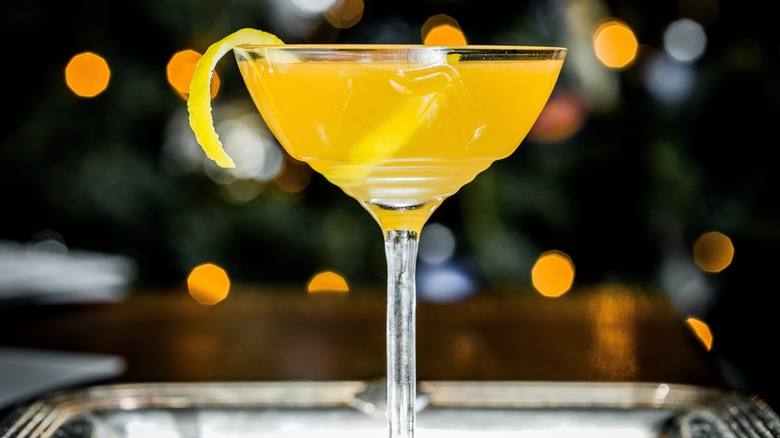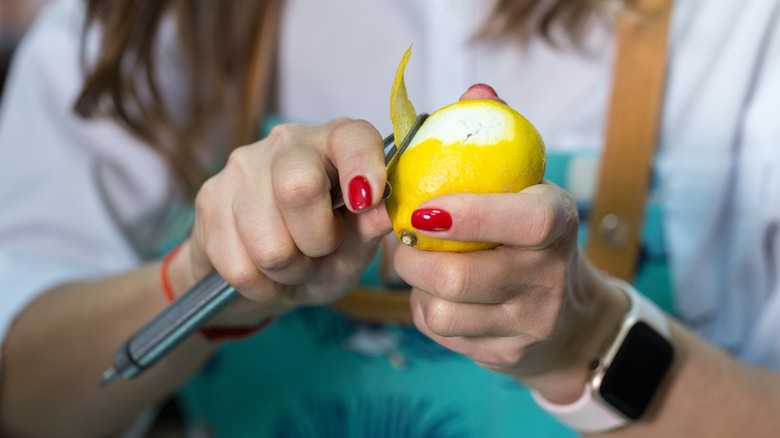Foolproof Tips For Cocktail Citrus Twists Every Home Bartender Should Know
When it comes to cocktail garnishes, the citrus twist is a classic choice. After all, not only do they look elegant and aesthetically pleasing, but they also infuse extra flavor into the drink, whether it's a simple cosmopolitan or a lemon drop martini. All that is to say is that if you're looking to expand your home bartending skills, mastering the citrus twist is a good place to start. To find out all the best tips and tricks to remember, Daily Meal spoke with an expert on the subject: Cody Goldstein, mixologist and the founder of hospitality company Muddling Memories.
To start with, what's the best kitchen tool to use to make the twist? According to Goldstein, many bartenders prefer the Y-peeler, which he says is "An excellent tool to get an excellent fresh peel with just a little bit of pith which adds a good backbone to the peel."
Another bartender choice is the channel knife, which Goldstein says bartenders use to make narrow twists. Conversely, Goldstein continues, "One recent option that has become a bartender's secret tool is a Boska cheese peeler, which is the safest way to peel and provides the thickest and most pristine peel."
Other options include the classic vegetable peeler or a paring knife. Of these two, the paring knife is the safer option — you may not be able to get a sturdy enough hold with the vegetable peeler.
What to know about making the citrus twists
Once you know which tool you'll be using, it's time to perfect your twist. As for how to do that, here's what Cody Goldstein recommends: "When forming a twist, the best method is to grab each end of the peel, twist the peel and pull tight from both sides. Hold for a few seconds and when you release you should have a nice curl."
If you're new to this, Goldstein notes that oranges and grapefruits are the easiest citrus fruits to work with for twists — because of their bigger surface areas, you have more room to get a sturdy hold while making the twist. He also says wider twists are easier than their thin counterpart, so you may want to stick to the wider shape when starting out. When you have more practice, you can branch out to smaller citrus fruits, like lemons or limes, and try your hand at thinner twists.
Another way to adjust the shape? The amount of pressure. Goldstein adds, "I also find that adjusting the amount of pressure you put on the peeler as you drag it through the fruit will change the thickness and can allow you to mold the citrus a bit more to your liking."
Can you make the citrus twists ahead of time?
Let's say you're hosting a dinner party complete with a cocktail hour and know that you will need plenty of garnishes made, but want to save time and make them ahead — is that possible? According to Cody Goldstein, the answer is yes, but you need to know how to properly store the twists.
"I have peeled citrus a day prior to using it and have vacuum sealed it to ensure it stays fresh and out of the air which will dry it out," Goldstein said, adding, "If you want to place peels in an airtight container with something damp like a paper towel, I would suggest placing it in the refrigerator until using."
Additionally, if you don't need to make them too far in advance, you can keep your peels in a container of ice-cold water, which will help them keep their shape and freshness. This is a good option if you want to make a few twists at once and then make the cocktails back to back.
You can also use the freezer to save the twists. Goldstein adds, "A frozen peel can also be a nice touch to keep your drink slightly chilled if you were to drop it in."


